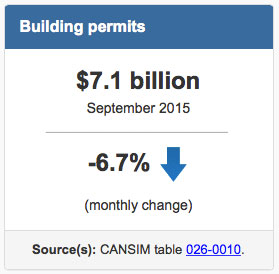Wholesale Sales Rose 0.3% in December
Mar 3, 2019
Wholesale sales rose 0.3% to $63.1 billion in December following a 1.1% decline in November. Sales were up in four of seven subsectors, representing about 64% of total wholesale sales. The motor vehicle and parts and the miscellaneous subsectors led the gains.
In volume terms, wholesale sales increased 0.3%.
In the fourth quarter, current dollar wholesale sales decreased 0.4%, the first decline following 10 consecutive quarterly gains. Constant dollar sales decreased for the second consecutive quarter, down 0.9%
Wholesale inventories were up 1.9% in December, pushing the inventory-to-sales ratio to 1.43—the highest level since November 1995.
December’s gain attributable to increases in four of seven subsectors
Following two consecutive months of declines, sales in the motor vehicle and parts subsector were up 3.7% to $10.9 billion in December, almost entirely due to higher sales in the motor vehicle industry (+5.8%).
The miscellaneous subsector rose for the fourth time in five months, up 2.0% to $8.7 billion in December. Sales were up in three of five industries, led by the agricultural supplies (+4.1%) and other miscellaneous (+3.6%) industries.
Sales in the building material and supplies subsector increased 0.7% to $9.1 billion, the first gain in three months. The lumber, millwork, hardware and other building supplies industry (+2.7%) reported the sole increase in December.
Of the three subsectors posting declines in December, the personal and household goods subsector recorded the largest decrease in dollar terms, down 3.2% to $8.7 billion. Three of the subsector’s six industries posted lower sales in December.
Higher sales in six provinces
Sales were up in six provinces in December, led by British Columbia.
Following three consecutive monthly declines, sales in British Columbia rose 2.2% to $6.5 billion in December. Higher sales in the food, beverage and tobacco (+8.2%) and the motor vehicle and parts (+9.5%) subsectors offset declines in others. Sales in the food, beverage and tobacco subsector increased for the second time in three months, reaching its highest level since August 2018, while sales in the motor vehicle and parts subsector rose for a second consecutive month.
In Saskatchewan, sales increased 4.0% to a record $2.5 billion, led by higher sales in the machinery, equipment and supplies (+6.8%) and the miscellaneous (+3.3%) subsectors.
In dollar terms, Quebec recorded the largest decrease in December, with sales down 1.4% to $11.5 billion. This was the fifth consecutive monthly decline for the province and the lowest level since March 2018. Sales were down in four subsectors, led by the personal and household goods (-5.5%) and the machinery, equipment and supplies (-4.9%) subsectors.
Wholesale sales in New Brunswick declined for the second consecutive month, down 2.8% to $533 million in December, led primarily by the food, beverage and tobacco subsector (-10.7%).
Inventories increase in December
Wholesale inventories increased for the fourth consecutive month, up 1.9% in December and surpassing the $90 billion mark for the first time ($90.3 billion). Inventories were up in five of the seven subsectors, representing about 73% of total wholesale inventories.
In dollar terms, inventories in the machinery, equipment and supplies subsector (+3.7%) recorded the largest month-to-month gain, following a 0.6% decline in November. All four industries within this subsector increased in December.
Inventories in the food, beverage and tobacco subsector (+6.7%) grew for the third consecutive month. Two of three industries rose within this subsector, with the food industry representing the largest increase.
Following two consecutive monthly gains, inventories in the motor vehicle and parts subsector (-0.2%) recorded the largest decline in dollar terms due to a decrease in the motor vehicle industry.
Inventories in the miscellaneous subsector (-0.1%) declined for the second consecutive month. The decrease was mostly attributable to lower inventories in the recyclable material and the agricultural supplies industries in December.
The inventory-to-sales ratio rose from 1.41 in November to 1.43 in December, the highest level since November 1995. This ratio is a measure of the time in months required to exhaust inventories if sales were to remain at their current level.
Wholesale sales in 2018
Wholesale trade in Canada rose for the ninth consecutive year, up 3.7% to $757.2 billion in 2018. Sales were up in six of seven subsectors, accounting for 83% of total wholesale sales.
In volume terms, wholesale sales were up 2.1% to $685.1 billion in 2018.
Growth in the wholesale trade sector in 2018 was mainly attributable to higher sales in the machinery, equipment and supplies subsector, followed by the building material and supplies subsector.
Sales were up in nine provinces, led by Ontario and Quebec.
According to the Survey of Employment, Payrolls and Hours, wholesale trade employed 802,030 Canadians on average from January to November 2018, up 3.1% after rising 0.5% over the same period in 2017. Average weekly earnings (including overtime) of people employed by wholesalers grew 2.0% to an average of $1,226 from January to November 2018. Over the same period, the wholesale trade sector accounted for 5.4% of Canada’s economic output as measured by gross domestic product.
The wholesale trade sector had 116,201 active business locations with employees in 2018. Excluding the oilseed and grain industry, petroleum and petroleum products subsector and agents and brokers, there were 105,471 active locations with employees in the wholesale trade sector.
Machinery, equipment and supplies subsector led the growth in 2018
The machinery, equipment and supplies subsector, which represented the largest share (21%) of total wholesale sales in 2018, increased 8.7% to $156.6 billion, its second consecutive annual gain. Sales were up in every industry, led by the construction, forestry, mining, and industrial machinery, equipment and supplies industry, which rose 12.6% to a record $51.5 billion, its third increase in five years. This was the industry’s highest growth rate since 2011 (+20.2%). The gains in this industry coincided with higher imports (+16.4%) and exports (+11.4%) of logging, construction, mining, and oil and gas field machinery and equipment from January to November 2018 (February release for the December 2018 reference month was delayed due to the US government shutdown).
The other machinery, equipment and supplies subsector increased for the fourth consecutive year, up 10.2% to $38.8 billion in 2018. Following two consecutive yearly declines, sales in the computer and communications equipment and supplies subsector rose 7.1% to $45.4 billion.
In volume terms, the machinery, equipment and supplies subsector increased 7.6%. The construction, forestry, mining, and industrial machinery, equipment and supplies industry (+10.8%) contributed the most to the gain.
Building material and supplies: Lumber and prices boost sales
The building material and supplies subsector increased for the ninth consecutive year, up 8.1% to $111.2 billion in 2018, on the strength of higher sales in all industries. The lumber, millwork, hardware and other building supplies industry contributed the most to the gain, up 5.8% to $55.2 billion and its seventh consecutive annual increase. Although this industry reported positive growth in 2018, it did not surpass the growth rate of 11.6% reached in 2017. Related indicators, including the total value of residential and non-residential building permits, increased 3.6% in 2018, after rising 10.9% in 2017. The Industrial Product Price Index for lumber and other wood products rose for the fourth consecutive year, up 7.1% in 2018 and its highest growth rate since 2004. The exports (+5.2%) and imports (+5.1%) of building and packaging materials also increased from January to November 2018. Conversely, housing starts declined 2.8% in 2018 after rising 12.0% in 2017.
Sales in the electrical, plumbing, heating and air-conditioning equipment and supplies industry rose 9.4% to $34.1 billion, the second consecutive gain.
In volume terms, sales in the building material and supplies subsector edged up 0.3%. The lumber, millwork, hardware and other building supplies industry, which led the gains in current dollars (+5.8%), declined 2.8% in volume terms in 2018.
Motor vehicle and parts: Sole subsector to decline
The motor vehicle and parts subsector, which accounted for 17% of total wholesale sales, was the lone subsector to decline in 2018, down 5.0% to $132.0 billion. The decline was led by the motor vehicle industry, which offset gains in the other two industries. Excluding this subsector, wholesale sales rose 5.8% in 2018.
Sales in the motor vehicle industry declined 6.6% to $105.3 billion in 2018, following eight consecutive annual gains. Many wholesalers are involved in international trade by importing and exporting goods. In particular, a large number of motor vehicles and motor vehicle parts are imported and exported by Canadian wholesalers. From January to November 2018, exports of motor vehicles and parts declined 3.4%, while imports of motor vehicles and parts edged up 0.2% following a 4.7% increase over the same period in 2017.
In volume terms, wholesale sales in the motor vehicle and parts subsector declined 5.9%.
Sales up in nine provinces in 2018, led by Ontario and Quebec
Wholesale sales increased in every province except Newfoundland and Labrador in 2018. Ontario contributed the most to the national gain, having generated half of total sales in 2018. Sales in Ontario increased 2.6% to $387.7 billion, on higher sales in the machinery, equipment and supplies (+9.8%) and the building material and supplies (+11.6%) subsectors. For both subsectors, sales were up in every industry. Conversely, the motor vehicle and parts subsector in Ontario declined for the first time in eight years, down 8.5% to $90.5 billion in 2018.
In Quebec, sales increased for the ninth consecutive year, up 5.6% to $139.1 billion in 2018. All the subsectors reported gains, led by the machinery, equipment and supplies (+10.3%) and the building material and supplies (+7.6%) subsectors. The machinery, equipment and supplies subsector increased for the second consecutive year, while the building material and supplies subsector was up for the third consecutive year.
Wholesale sales rose 5.2% in both Alberta and British Columbia in 2018. Sales in Alberta reached $82.1 billion as a result of higher sales in the machinery, equipment and supplies (+7.7%) and the building material and supplies (+5.1%) subsectors. In British Columbia, six of seven subsectors increased, led by the machinery, equipment and supplies (+8.3%) and the food, beverage and tobacco (+6.0%) subsectors.
Newfoundland and Labrador recorded the sole decline among the provinces in 2018, down 2.2% to $4.3 billion, marking the third consecutive annual decline.
Source: Statistics Canada, www150.statcan.gc.ca/n1/daily-quotidien/190221/dq190221a-eng.htm?CMP=mstatcan










